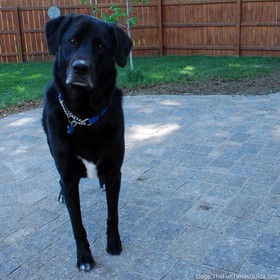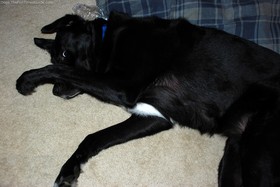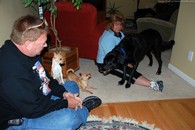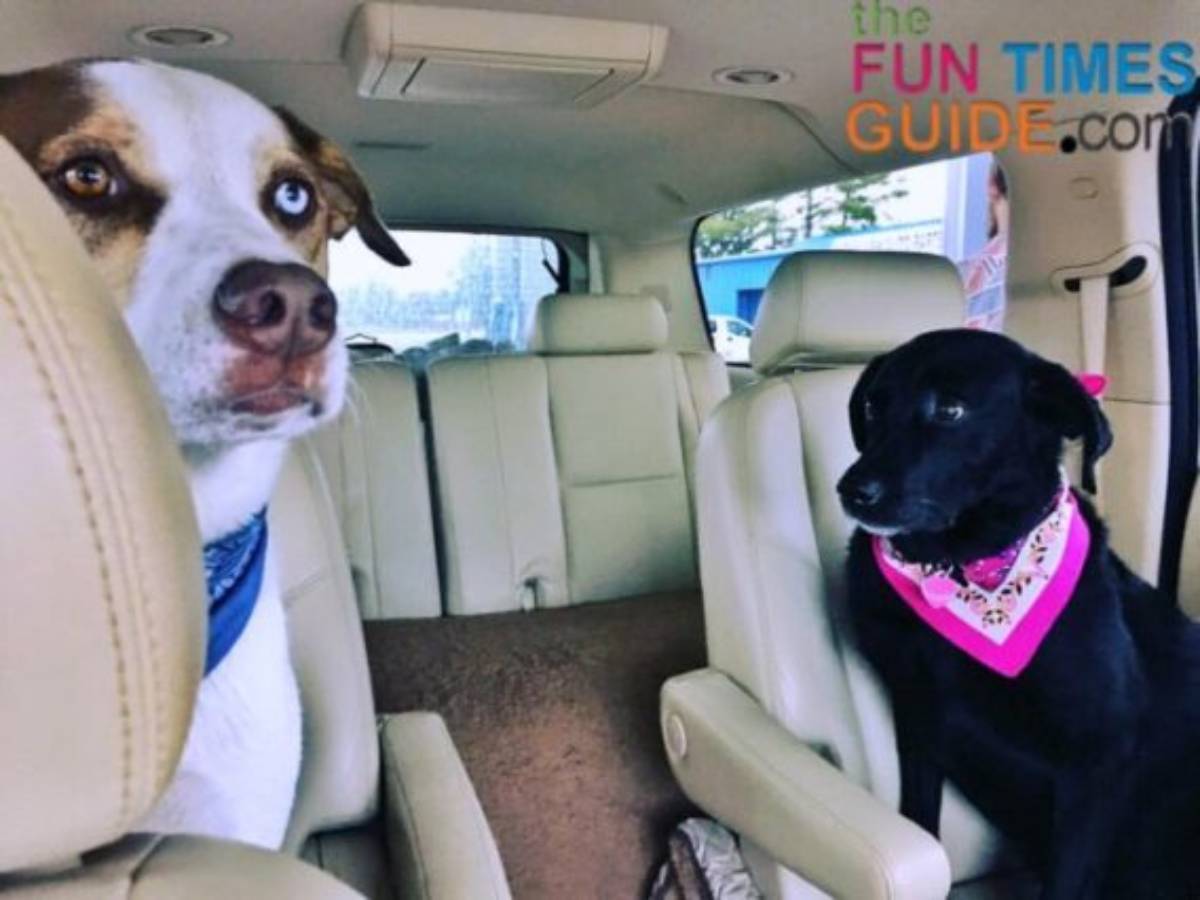 For years, our dog Tenor would bark uncontrollably and become quite nervous around strangers and people that we would allow inside our home.
For years, our dog Tenor would bark uncontrollably and become quite nervous around strangers and people that we would allow inside our home.
Now, he’s 3 years old, and it’s been getting progressively worse.
That is, until we asked for help from our personal dog trainer, Suzy Godsey.
For us, the act of getting our dog to feel completely comfortable with guests inside our home was a 2-step process.
- Step #1: Stop the barking
- Step #2: Get our dog to sit calmly around strangers
How To Stop Dog Barking
For starters, we had to tackle Tenor’s uncontrollable barking.
Normally, Tenor was a quiet and friendly dog.
But he would bark nervously any time he saw strangers walking on the sidewalk outside our home, or if someone would knock (or ring the doorbell) at our house.
It wasn’t an aggressive bark. It was as if he was simply warning us that someone was getting close to our house and he just thought we’d want to know. That’s all. (But still, it was a bit much.)
Thanks to Suzy’s tips and advice, we have practically eliminated Tenor’s barking during those situations.
2 Best Tips For Barking Dogs
Since the barking usually continued after a guest entered our home as well, it was up to us to remain in control of the situation and assure Tenor that everything was okay — that this person was allowed to be in our home.
In my opinion, 2 things made the biggest difference at putting an end to the barking:
#1 Things got easier after we learned to “tune in” to Tenor — eye to eye — before, during, and after guests arrived at our home. Simply stating “I got it” (while remaining calm) assured Tenor that we were acknowledging what he was telling us, and we were in control of the situation. He learned that after we acknowledged him, he no longer had to worry about that situation any longer.
It is obvious that Tenor watches us closely (looking for guidance and reassurance), and now he calms right down whenever strangers arrive at our house. We are now concentrating daily on the cues we give Tenor throughout each day. (It’s pretty amazing). And now we are better at giving him the proper cues, and he is better at paying attention to them. It’s a win-win.
#2 It was important that we asked our guests not to look at Tenor — because he was feeling threatened by them and uncertain as to how to handle their physical and verbal cues.
It was clear that any time our guests would completely ignore Tenor after they had entered our home, Tenor would warm up to them on his own terms. He simply didn’t feel as threatened by them this way. And since he was more curious in them than they were in him, he actually warmed up to them much more quickly.
After Tenor Stopped Barking, He Was Still Quite Nervous
 Even after we got a handle on the barking, Tenor would still rather be in a different room of the house, rather than right there in the center of the action with guests in our home.
Even after we got a handle on the barking, Tenor would still rather be in a different room of the house, rather than right there in the center of the action with guests in our home.
Worse yet, any time a guest in our home would physically move (as if to tie their shoe, scratch their arm, or walk to the bathroom), Tenor would suddenly dart away… fast as lightening!
This was even the case if the visitor would reach out to pet Tenor, or give him a treat. Obviously, this was quite frustrating for both us and our guests (who were simply trying to be friendly toward our dog).
When I mentioned this to Suzy, here’s what she suggested:
For Tenor to completely relax around strangers, you might try the putting him on the leash for the first 10 minutes while a guest is in your home. Make sure to sit really close to your house guest, and with Tenor on the leash let the person get up a few times and see how he reacts. According to his past behavior, he will probably want to dart away. So just correct him (like you did when training him to get used to strangers at the door), and show him that you are in full control of the situation and that he doesn’t have to worry about this person moving around.
Then, give Tenor a treat as soon as he does not react to the person’s movements anymore. Also, while Tenor is on the leash in your house and getting used to guests right after they enter your home, encourage your guests to speak loud, clap their hands, stand up then sit down… just regular stuff that people do. See how it goes!
So, we made a point to follow Suzy’s suggestions the next few times we had guests inside our home.
Do This Before Guests Enter The House
We started by putting Tenor on an 8-foot leash before a guest entered our home. This simple act alone almost immediately put Tenor into a calmer state! It was amazing — like night and day.
The reason this worked: because Tenor knew that whenever he is on the leash, we are 100% in control — of everything. So, he only had to watch our eyes to see what we expected of him. And because we are so “in tune” with our dog, any time we are calm, he is calm. Any time we are stressed, he is stressed. It’s amazing the direct correlation.
Thanks to this tip alone (putting a leash on your dog before guests enter the house), Tenor now completely focuses on us — at the end of the leash — rather than focusing so much on the guest in those first moments after someone enters our home.
Yes, Tenor still watches them. But he sits calmly at our feet while watching them! This is a huge improvement, because he would normally run into the other room and watch them from afar because he was so fearful of them — it was like sensory overload for him and he just didn’t know how to react to their voices, their movements, their eyes and body language.
Do This After Guests Enter The House
After a guest had entered our home and took a seat — and Tenor was sitting calmly at our feet — we initially took Tenor o
ff the leash to allow him to roam freely and interact with our guests.
This didn’t work! It was too soon.
We decided to follow Suzy’s second piece of advice: encourage your guests to move, make noise, do things that guests normally do inside the home — all the while keeping Tenor on the leash.
I guess this is a way to help Tenor “work through his fear” — especially since we already know that Tenor is 100% at ease, as long as either Jim or myself it at the other end of that leash.
It worked!
The moment we re-attached the leash to Tenor’s collar, he became a different dog. He actually wanted to go up to our guests, and he wanted to be petted by them, he was just to fearful to do it on his own. He needed the assurance that we were on the end of that leash to protect him and/or he could “sense” what was appropriate behavior by how we were reacting to his actions while on the leash.
Whatever it was, I tell you we have a whole new dog around guests and strangers now! The leash made all the difference. Eventually (within minutes), we were able to take him off the leash and the guest was able to move freely without Tenor getting all jumpy. With each movement they made, he would simply look at us for clues on how we were reacting and how he was supposed to react. Since we were excited and praised him for interacting calmly with our guests, he was excited and happy to be interacting calmly with our guests.
Completely amazing. What a transformation. All it took was the simple act of using a leash inside our home! Who’d a thunk it?!
I cannot stress enough how much Tenor has become a much more social dog and much less fearful and nervous around strangers.
Why Such A Fearful Dog?
If you’re wondering how this otherwise friendly and social dog can be so fearful and nervous around strangers… I blame it on us.
We failed to socialize Tenor around people when he was a puppy. Pretty much, the only people he met during that first year of his life were veterinarians and doctors who poked and prodded him.
So now that he’s 3 years old, he is finally working his way through our mistake.
If you’ve got a young puppy, please please please try to make sure your dog is encouraged to interact with both dogs and people. It really does make a difference.
By the way, we did a good job of properly socializing Tenor around other dogs when he was a puppy. As a result, he’s perfectly fine and very social around other dogs and even people who enter our home with dogs. But if you don’t have a dog, he’s not sure what you’re all about… that’s when he gets nervous. Or should I say he used to get nervous!






